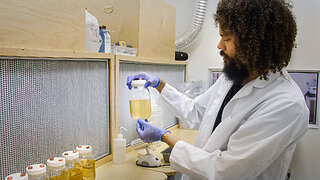Hypoxic Stem Cells - New Tech or Clever Marketing?
www.dreambody.clinic (833) 445-9089 info@dreambodyclinic.net facebook.com/dreambodyclinic
Hypoxic Stem Cells - New Tech or Clever Marketing?
] Hi, this is Josh with dream body clinic. And today we're gonna be talking a bit about hypoxic stem cells. This has been a term that it's become popular lately. I've been hearing a lot on YouTube and other places, and I want to explain what it is because it sounds really cool, really catchy, like it's something new, but it's really not.
So a hypoxic stem cell in regards to mesenchymal stem cells like we use and other clinics like us is hypoxic simply means a low oxygen environment. So typically what this means is that that lab is using a bioreactor and a bioreactor. I'll try to get a [00:01:00] video up here. If I can find some images and whatnot, but a bioreactor is a great way to cultivate mesenchymal stem cells.
It is self contained. It has the culturing medium in it in large quantities. It keeps the temperature perfect, and you're able to do a culture of stem cells that way with very large batches. Which is pretty cool, but there's some drawbacks to that that they don't tell you about. So when you use a bioreactor, and the reason we don't use one, we prefer to use incubators, is because the bioreactor creates very large, large cultivations.
You're using a lot of culturing medium. You get huge numbers of stem cells. And when you do that, they all have to come out at the same time. So it's most likely most clinics aren't going to have, you know, like a thousand patients for one day. It just doesn't make sense, right? You couldn't even treat that many people.
So what they have to do then is cryogenically freeze [00:02:00] those cells to be used for later. Now there's some good and bad about frozen cells. Most research facilities. Use frozen mesenchymal stem cells. But the thing is you have to thaw them properly. There are special devices, these baths that you have to have ice baths to slowly thaw the cells, because if they.
Thaw too fast, you actually kill up to half or more of the stem cells in that batch. So we prefer to just avoid that completely and not use frozen stem cells. We don't want to run that risk of having dead cells. And when you cryogenically freeze the cells. Typically have to add DMSO and DMSO will raise the freezing temperature so that you're able to freeze them faster and lower die off during the freezing process because they can die from that too.
Like when you throw a Coca Cola in the freezer, you know, it can explode. You've seen it like imagine a cell that is like mostly water [00:03:00] in the membrane. It can expand too far and explode. So. They have to do these things and DMSO in like an IV is great. We actually add DMSO to our IVs beforehand to open the blood brain barrier for about 20 minutes.
But when you're injecting that into a joint, it almost always causes inflammation. So that's a big issue with. Frozen mesenchymal stem cells, like they're using in the U S with umbilical cord tissue and with labs that are using a bioreactor for their hypoxic stem cells. And technically all cells are grown in a hypoxic environment because it's in a culturing medium.
It is a liquid. It is not full of oxygen. So they try to make it sound like, Oh, this is some better way to do it, but it's actually the normal way, because even with an incubator, like we use, it's more like baking. You know, if you go to that really great French bakery every day, they got fresh croissants, fresh baguettes.
These are the things you want. You know, you [00:04:00] want them fresh. You don't want them stale a day or two old. So that's what we do with the stem cells. We cultivate them. We get them into patients within 24 hours of cultivation. So they can have the freshest, best stem cells that were never frozen. So that's what we do with that.
That's why we don't use a bioreactor and we easily could. It just doesn't make sense because we want to give the best quality stem cells. We can never frozen. We want to replicate them because that's where you get the best quality. Imagine they're growing up in this garden of Eden. They have every nutrient they need.
They have the perfect temperature in the incubator. They are just ready to replicate. And then when they get in you, they're ready to work. And these, like I like to always say, they're like the managers on the construction site, they seek out the inflammation and they guide the repair process. So it back to that hypoxic environment, low oxygen environment in this bioreactor, because we can see it.
-
 2:19
2:19
Dream Body Clinic
8 months agoHow Ron relieved his chronic migraines with stem cell therapy
138 -
 35:50
35:50
TheTapeLibrary
1 day ago $0.02 earnedThe Disturbing True Story of The Amityville Horror
19.6K12 -
 8:13
8:13
Memology 101
1 day ago $0.03 earnedABSOLUTE CHAOS as MTG, AOC & Crockett trade insults during AG Garland Contempt Hearing
21.3K110 -
 11:26
11:26
Blue Siesta ASMR
1 day agoBETWEEN LIFE AND DEATH IN CANCUN
21.3K15 -
 15:36
15:36
Landed Fishing
2 days ago $0.01 earnedCatching Tarpon with Crab in Boca Grande! The Silver King Capital of the World New Fishing Gear 2024
21.3K4 -
 6:28
6:28
JoBlo Horror Originals
1 day agoWe Remember Roger Corman
22.5K3 -
 5:29
5:29
Michael Heaver
1 day agoDutch Finally Make ASTONISHING Decision
20.8K27 -
 30:42
30:42
Southwest Mushrooms
1 day ago $0.01 earnedMushroom Mycelium Tissue Culturing in Liquid and Agar Media | Southwest Mushrooms
15.5K2 -
 3:47
3:47
tksgarage
1 day agoTim Kuniskis Out As Dodge CEO!
12.6K3 -
 27:52
27:52
The Bitcoin Family
1 day ago $0.04 earnedBITCOIN 66K, NEXT TARGET IS CLEAR!!!
10.1K8